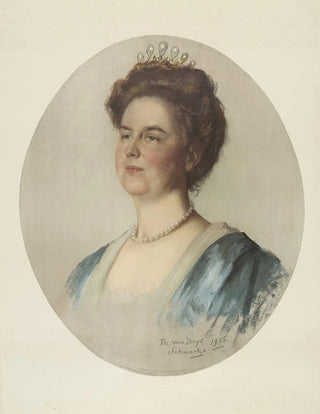Art print | Portrait of Wilhelmine, Queen of the Netherlands - Thérèse Schwartze Source: Reproduction | Portrait de Wilhelmine, reine des Pays-Bas - Thérèse Schwartze


View from behind

Frame (optional)
Reproduction Portrait of Wilhelmine, Queen of the Netherlands - Thérèse Schwartze – Captivating Introduction
The "Portrait of Wilhelmine, Queen of the Netherlands" by Thérèse Schwartze is a work that transcends the simple pictorial frame to immerse us in the universe of a rich era full of history and emotion. Through this portrait, the artist manages to capture not only the appearance of the queen but also her essence, charisma, and dignity. Every brushstroke seems to vibrate with a life of its own, inviting the viewer to explore the nuances of this iconic figure's personality. This painting, a true reflection of early 20th-century Dutch society, offers us a window into a bygone world, while remaining strikingly relevant today.
Style and uniqueness of the work
Thérèse Schwartze's style is characterized by remarkable finesse and particular attention to detail. In the "Portrait of Wilhelmine," the chosen color palette evokes a softness and warmth that envelop the subject with an almost regal aura. The drapes of the queen's dress, with their rich texture and movement, testify to exceptional craftsmanship. The play of light and shadow accentuates the delicate features of her face, highlighting her penetrating gaze that seems to tell a thousand stories. This portrait is not limited to a simple representation but becomes a dialogue between the artist and the model, a meeting where the past and present converge.
The artist and her influence
Thérèse Schwartze, a prominent figure in Dutch painting, managed to establish herself in an artistic environment often dominated by men. Her career, marked by success, was driven by a deep commitment to the representation of women in art. By choosing to paint portraits of influential women, she not only celebrated their beauty but also highlighted their role in society. Her intimate and empathetic approach redefined the standards of portraiture of her time, leaving a lasting imprint on the generations of artists who followed her. The "Portrait of Wilhelmine" is a perfect example of this vision, where the artist succeeds in establishing a strong emotional connection between the viewer and the subject.
A wall decoration of

Matte finish

View from behind

Frame (optional)
Reproduction Portrait of Wilhelmine, Queen of the Netherlands - Thérèse Schwartze – Captivating Introduction
The "Portrait of Wilhelmine, Queen of the Netherlands" by Thérèse Schwartze is a work that transcends the simple pictorial frame to immerse us in the universe of a rich era full of history and emotion. Through this portrait, the artist manages to capture not only the appearance of the queen but also her essence, charisma, and dignity. Every brushstroke seems to vibrate with a life of its own, inviting the viewer to explore the nuances of this iconic figure's personality. This painting, a true reflection of early 20th-century Dutch society, offers us a window into a bygone world, while remaining strikingly relevant today.
Style and uniqueness of the work
Thérèse Schwartze's style is characterized by remarkable finesse and particular attention to detail. In the "Portrait of Wilhelmine," the chosen color palette evokes a softness and warmth that envelop the subject with an almost regal aura. The drapes of the queen's dress, with their rich texture and movement, testify to exceptional craftsmanship. The play of light and shadow accentuates the delicate features of her face, highlighting her penetrating gaze that seems to tell a thousand stories. This portrait is not limited to a simple representation but becomes a dialogue between the artist and the model, a meeting where the past and present converge.
The artist and her influence
Thérèse Schwartze, a prominent figure in Dutch painting, managed to establish herself in an artistic environment often dominated by men. Her career, marked by success, was driven by a deep commitment to the representation of women in art. By choosing to paint portraits of influential women, she not only celebrated their beauty but also highlighted their role in society. Her intimate and empathetic approach redefined the standards of portraiture of her time, leaving a lasting imprint on the generations of artists who followed her. The "Portrait of Wilhelmine" is a perfect example of this vision, where the artist succeeds in establishing a strong emotional connection between the viewer and the subject.
A wall decoration of






